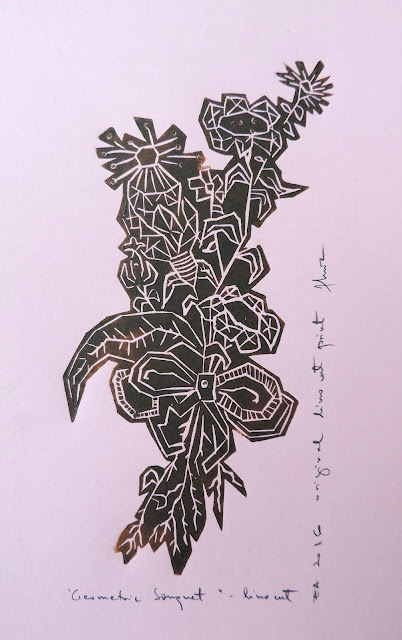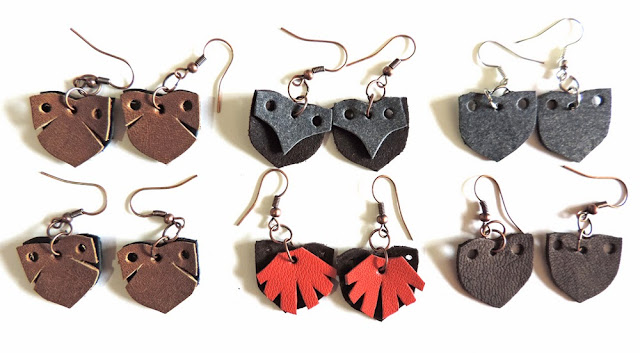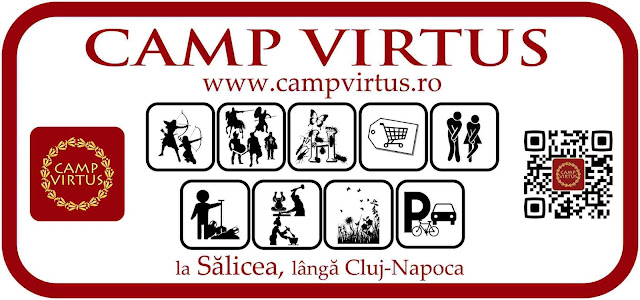A valuable art piece has returned on display at the History of Pharmacy Museum of Cluj. It is a large painting, oil on canvas, depicting the portrait of pharmacist Pal Hrobonyi of Gherla. The piece was painted in 1877 by the well-known local artist Endre Kőváry who studied in Wien and then specialized in portraiture and landscape painting in Cluj, where he was also active as art teacher. An interesting detail is the fact that the work is signed and dated and that written sources attest that it was made after a photograph of the subject - a practice not unknown to the painter, as a similar portrait made after a photograph is preserved in the Art Museum of Cluj (it depicts baron Banffy Daniel).
31/03/2016
30/03/2016
Logo and marketing
Establishing a handmade company proved quite a challenge for me as an artist as a historian. Atelierul de istorie clearly needed a logo, so I started making a linocut with the ancient Dacian war standard - the Draco, that is available as a framed printwork. The linoprint is rather large, as I wanted to have all the details in good quality. It ended up in two pieces, as my standard linos were smaller than that :) I was able to find the good in the situation and the Draco head is also available, as a smaller framed print.
Still, it looked too arty and too little as a logo, so I turned to a designer for help. He worked the image and generated the logo, as I though it should be: stylized, colorful, comprehensive.
The final step was to have to logo on several products, besides the handmade ones. We chose cotton shopping bags in natural color and T-shirts with the Draco imprinted through serigraphic transfer.
Labels:
atelieruldeistorie,
Dacian draco,
linocut,
logo,
marketing,
serigraphic transfer,
serigraphy
29/03/2016
Tulips in Transylvania
The introduction of tulip to Europe is attributed to the Ottomans and dated to the mid-end of the sixteenth century, followed by the famous Tulipmania (also called the Tulipomania or the Tulip Fever) of the United Provinces (currently the Netherlands) towards the middle of the seventeenth century. But tulips also got to central and eastern Europe. In 1573 bulbs were planted in the imperial botanical Gardens of Vienna, for example. In Transylvania it remains yet unclear when and how the new oriental flowers were introduced - the only possible sources on the matter are for now depictions of the flowers on various types of decorative objects: carpets, embroideries, stove tiles. Ottoman carpets, with various uses in Transylvania, might have been themselves, and not the actual flowers, sources of inspiration for the latter, locally-produced artefacts. See below two such tulip-decorated stove tiles, probably dated to the second half of the seventeenth century, specific to the area of Cluj-Napoca. Tulips became frequent decorative motifs in folk art during the eighteenth and nineteenth century in the province, though the history of the plants remains unclear.
These tiles must have been very fashionable at the time, even deemed exotic and Turkish. Similar lyre-shaped tulips on straight stems starting from large bulbs were associated to even more "revolutionary" images, such as tobacco-smoking riders.
28/03/2016
Gardening project
One might be surprised of what art has to do with a gardening project. And yet, I have devised such a combination, relating to the idea of a Roman aromatic garden. The "Roman garden" product is a small bottle, painted by hand with vegetal depictions, containing a mix of seeds from plants that the Romans would have grown to use in the kitchen, for cooking or spicing wine, or just for their nice scent. It has coriander, dill, mustard, parsley, mint, sage, basil, savory, caraway, and rosemary seeds, to be planted and cared for in an authentic Roman garden. The project is educational for kids, useful for reenactors, and fun for all those who love herbs and cooking.
 |
| the Roman garden project |
 |
| hand-painted bottle with aromatic plant seeds |
 |
| contents ca. 25 g, enough for a rather large herb garden |
Labels:
ancient Roman,
reenactment,
Roman cooking,
Roman garden,
Roman herbs
27/03/2016
Handmade leather wallet with DRACO
Atelierul de istorie continues with their tooled leather projects inspired by history and popular depictions.
The latest wallets are inspired by the ancient Dacian civilization, namely by the war standard of this people, the half wolf-half snake DRACO. The different variants of such crafted leather wallets to be found on the website, HERE. They are produced for Romania - with one larger pocket for the ID card. Each wallet is entirely made by hand - cutting, tooling, dyeing, sewing, burnishing.
You can now subscribe to the shop's newsletter to keep up with the latest art, reenactment and handmade products.
26/03/2016
My geometric bouquet
As I've explained in the previous post, this week's linocut project was flowers: dried ones, geometric ones, stylized, minimalist, in natural colors - to avoid the inherent "sweetness" of flower depictions. The result is a small series of works in which I have played with the typographic ink color, hues, and combinations, and with the date&title&technique&signature which is an organic part of the image. So here is the geometric bouquet, in its several variants, plus the lino and the cutting tool. The prints are available on my Etsy shop.
 |
| my favorite: overlapping colors |
 |
| typographic ink applied with the sponge |
 |
| stronger contrast - dark brown on white paper |
 |
| different integration of text and image - and a strange pink paper |
 |
| detail of the sponge-applied color |
 |
| the lino block |
 |
| lino block, print, and gauge tool |
25/03/2016
Geometric flowers
I've been reprimanded for not creating paintings with flowers. I know this is the universal subject for common artwork, but I find it extremely challenging. Depicting flowers in art is treacherous and the result often kitschy -
rendering them geometrically is one way of avoiding the issue. Here are
some of my favorite examples, a bit of research actually for the next art project, collected in another Etsy treasury.
24/03/2016
Ancient Dacian owls
As artifacts indicate, the ancient Dacians were keen on depicting animals - real, exotic, or imaginary. Among them one finds frequent representations of aquatic birds and owls. The latter are very sketchy and some have interpreted such images found on silver and gold bracelets as simple palmettos. I choose to believe they are in fact abstracted owls and was inspired to created a small series of handmade leather earrings. The earrings include various color combinations and decorative effects - hand cut and perforated. They can be acquired via my online store.
 |
| Owl leather earrings - 1.5 cm in length |
 |
| Handmade leather earrings inspired by ancient Dacian owl depictions |
 |
| Detail of the palmetto/owl part of various types of Dacian gold spiral bracelets |
 |
| Detail of such an ancient Dacian gold jewelry piece |
23/03/2016
Aurant cortex (orange peel)
Citrus fruits started to be used in Transylvania during the seventeenth century and in the
subsequent century they were still rare imported goods. During the 1750s, when
the Austrians introduced the first state sanitary measures, oranges, lemons and
other spices sold also by the apothecary were excepted from border quarantine.
In 1793 Tobias Maucksch, owner of the pharmacy in Cuj that hosts the museum,
taught his son, a pharmacist to be, how to offer gifts to the good doctors in
town for the New Year: doctors who enjoyed a certain reputation and wrote
numerous prescription, he should offer six lemon, while doctors with less
experience and activity should be content with receiving just three.
 |
| Bitter orange botanical drawing |
Oranges were highly appreciated by the
apothecaries, in the form of peel extract of powder or as oil, syrup, and
tinctures made from the plant’s flowers and peel. Such medicine was recommended
for the tonic and antispasmodic effects and for various stomach troubles, but
they were also used for the pleasant taste in mixed drugs (and even the Elixir
of Love!).
 |
| pottery jar for orange peel syrup |
The History of Pharmacy collection in Cluj-Napoca includes 15
pharmaceutical jars, made of various materials, for products obtained from the
peel or flowers of the „golden fruit” (Lat. aurant),
attesting to their popularity:
§
wooden jar with the painted signature “PULV.
AURANT. CORT.” (orange peel powder), 19th century, from a pharmacy
in Baia Mare
§
porcelain jar with the signature “EXTR. AURANT.”
(orange extract), 19th century, from the Engel Pharmacy in Iaşi
§
jar made of glazed pottery marked “Syr. Aurant.
Cort.” (orange peel syrup), 18th century, from the Velits Pharmacy
in Turda
§
blue glass jar “OL. AURANT. FLOR” (orange flower
oil), 20th century, St. George’s Pharmacy in Cluj (hosted in the Maucksc-Hintz House, where the museum has been hosted for the last 60 years).
 |
| glass jar for orange flower oil |
22/03/2016
Drawings on Etsy
Though apparently easy to make, drawings and sketches are often the test of one's skill as an artist. They are also the basis of other artistic endeavors and thus even more important. I therefore greatly appreciate well-made drawings, in pencil, ink, charcoal, or various combinations. Here is my most recent Etsy treasury that reunites such finds. Fresh and pure, drawing should not be overlooked as an art form :)
21/03/2016
Branding - CAMP VIRTUS
We've had trouble finding a slogan in Romanian for our reenactment park Camp Virtus. It is intended as a theme park (historical), but it is not a park per se (though it will have a Roman garden). It is not an entertainment venue, as it is more educational in nature (though there will be reenactment shows). It is not at Antiquity park, as we might organize presentations of other historical periods and even other types of events all together (fairs, concerts). Even more, the term reenactment is not well known in Romanian and might not get the message through to all types of intended public.
When words fail, we turned to images - of activities and facilities on site. What do you think? Suggestions are welcome, as we are not PR specialists, but mere reenactors :) For more info on the Camp, see our website HERE.
19/03/2016
Monuments in Luncani, Cluj County, Transylvania
The village of Luncani (Hungarian Aranyosgerend), in Cluj County, Transylvania, holds two special monuments of medieval and early modern architecture: the church, attested in 1290, and the Kemény-Bánffy castle of the seventeenth century. The church is well preserved, with Romanesque and early Gothic elements, inclusions of ancient Roman sculptural reliefs, and traces of medieval wall painting inside. The castle, located nearby, is unfortunately almost a ruin. Visited March 2016.
Labels:
Banffy,
Baroque castle,
Kemeny,
Luncani,
monuments,
Romanesque church,
Transylvania
18/03/2016
Theriac
Theriac, also called Confectio Andromacha or Electuarium Anodynum cum opio
was a famous drug used as panaceum,
initially an antidote for snake bites and poison and last resort drug for patients in
terminal stages. When opium was added, it became an effective pain killer. The recipe was first devised by the ancient Greeks (Mithridatum), completed
by emperor Nero’s personal physician, and perfected by the Venetians during the
late Middle Ages and the Early Modern Period. The preparation there was a public spectacle and a matter of state.
Theriac contained up to 40
ingredients, its preparation lasted up to 12 years, and was thus extremely
expensive. It contained, among others, opium and viper flesh. In Transylvania it was used until the nineteenth century and
was brought in by Italian merchants. The History of Pharmacy Collection in Cluj contained one labeled glass jar for Theriaca, dated to the nineteenth century, and two eighteenth-century metal cases with the product.
 | ||||
| peasant-preparing-an-ointment-to-protect-against-snakes-from-the-theriaca-of-nicander-of-colophon |
 |
| "Theriaca" apothecary jar sold in Transylvania (Baia Mare, the pharmacy of Szendey Antal) in the nineteenth century |
 |
| Eighteenth-century cases with Theriaca, sold by apothecaries in Transylvania |
 |
| The public preparation of the theriac in Venice |
17/03/2016
Easter series
My Etsy offer for Easter includes a series of three miniatures, created in the same technique - linocut, collage, acrylic. They are ready to hang and the small format (20 x 20 cm) makes them suitable for a sunny narrow wall strip in the house, workplace, or shop. They don't need frames as the painting continues on the sides of the canvas. The subject matter is light (cities, homes, people and places) and the style decorative, modern, in natural colors.
Medieval story - original painting on canvas; mixed technique, linocut, acrylic, collage
Return home - original painting on canvas; mixed technique, linocut, acrylic, collage
Life in the city - original painting, mixed technique (linocut, collage, acrylic on canvas), ready to hang
Labels:
Ana Maria Gruia,
Easter gift,
Etsy shop,
original painting
Subscribe to:
Posts (Atom)



























